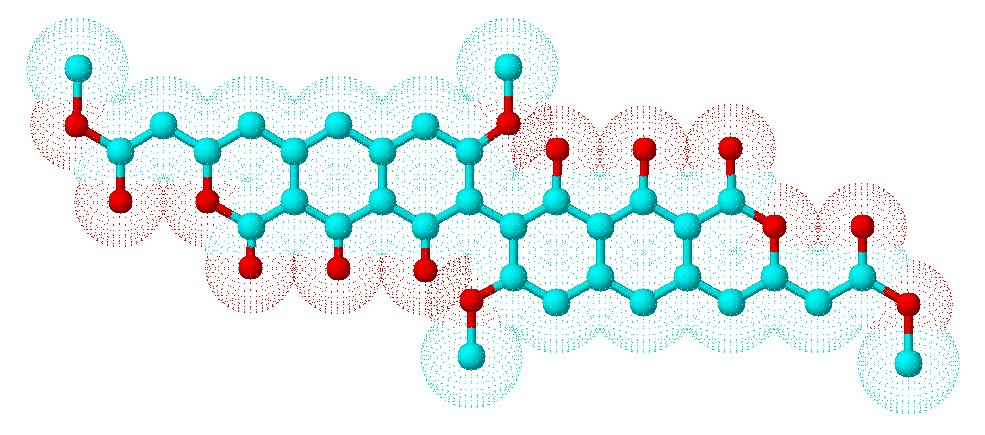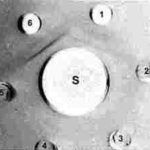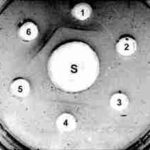Date: 26 November 2013
Secondary metabolites, 3D structure: Trivial name – viriditoxin
Copyright: n/a
Notes:
Species: A. brevipes, A. fumigatus, A. viridinutansSystematic name: (8,8′-Bi-1H-naphtho(2,3-c)pyran)-3,3′-diacetic acid, 3,3′,4,4′-tetrahydro- 9,9′,10,10′-tetrahydroxy-7,7′-dimethoxy-1,1′-dioxo-, dimethyl ester (8,8′-BI-1H-NAPHTHO(2,3-c)PYRAN)-3,3′-DIACETIC ACID, 3,3′,4,4′-TETRAHYDRO-9,9′,1 3,3′,4,4′-Tetrahydro-9,9′,10,Molecular formulae: C34H30O14Molecular weight: 662.594Chemical abstracts number: 35483-50-2Selected references: CURRENT STATUS OF RESEARCH IN MYCOTOXIN-INDUCED TERATOGENESIS HOOD RD; SZCZECH GM EXCERPTA MED INT CONGR SER (426):96,1977TOXINS STACK ME SHERMA, J. AND B. FRIED (ED.). CHROMATOGRAPHIC SCIENCE SERIES, VOL. 71. HANDBOOK OF THIN-LAYER CHROMATOGRAPHY, SECOND EDITION. XV+1104P. MARCEL DEKKER, INC.: NEW YORK, NEW YORK, USA; BASEL, SWITZERLAND. ISBN 0-8247-9454-0.; 71 (0). 1996. 1033-1045.DAVIS ND. Sterigmatocystin and other mycotoxins produced by Aspergillus spp.. J FOOD PROT; 44 (9). 1981. 711-714, 722. Lillehoj EB, Milburn MS. Appl Microbiol. 1973 Aug;26(2):202-5. Viriditoxin production by Aspergillus viridi-nutans and related species.Toxicity: Intraperitoneal LD50 2.8 mg/kg body-weight in male mice.mouse LD50 intraperitoneal 2800ug/kg (2.8mg/kg) CRC Handbook of Antibiotic Compounds, Vols.1- , Berdy, J., Boca Raton, FL, CRC Press, 1980Vol. 5, Pg. 408, 1981.
Images library
-
Title
Legend
-
Left= an agar air plate exposed for 2 minutes after the barley had been turned. showing numerous colonies of the fungus following incubation at 26C on 2% malt agar.Right= A sputum sample taken from a maltworker after exposure showing many fungal colonies when cultured on agar. His commensal yeast flora is seen towards the right base as cream/white colonies.

-
growing on contaminated barley malt. The deep blue-green heads made up of chains of conidia are seen on the left. On the right, conidiophores from which conidial chains are developed show typical clavate heads. Stain- Cotton blue in Lactophenol.

-
Sections of colonised alveoli
On the left, the conidiophores sporulate freely, on the right they are seen to cease development at the phialide stage. Carbon deposits are clearly seen here.A=alveolus, As=alveolar septum, C=conidiophore, P=phialide
-
The growth isolated from the aspergilloma in the presence of living cells of the three bacterial species in culture.The most marked inhibition occurred with Pseudomonas aeruginosa(P) and Haemophilus influenzae(H) and to a much lesser extent with Staphylococcus aureus(S). C=control. Inhibitory factors were components of the bacterial slime layers.
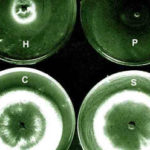
-
aspergilloma removed from the lung cavity seen in section.Staining was with methenamine/silver and light green. The structure shows zonation probably due to variations in the growth rate of mycelium(deep brown). A mucus layer(stained green) containing cell debris and bacteria is seen shrouding the fungus. Bacterial genera were Staphylococcus, Haemophilus and Pseudodomonas.

-
Plugs cultured on agarA young colony of the fungus(AF) has a central patch of sporulation and is surrounded by colonies of bacteria and yeasts.
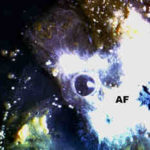
-
A part of the mycelium in a stained sputum plug showing the dichotomously branched hyphae of Aspergillus fumigatus.


